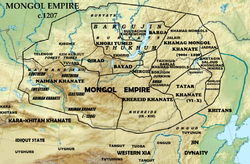Merkit
This article needs additional citations for verification. (December 2011) |
Three Mergids ᠮᠡᠷᠬᠢᠳ | |||||||||||
|---|---|---|---|---|---|---|---|---|---|---|---|
| 11th century–1200 | |||||||||||
 Mongol Empire c.1207 | |||||||||||
| Status | nomadic confederacy | ||||||||||
| Capital | Not specified | ||||||||||
| Religion | Shamanism | ||||||||||
| Government | Elective monarchy | ||||||||||
| Khan | |||||||||||
| Historical era | Post-classical Central Asia | ||||||||||
• Established | 11th century | ||||||||||
• Disestablished | 1200 | ||||||||||
| |||||||||||
| Today part of | Mongolia Russia (Buryatia) | ||||||||||
| History of Mongolia |
|---|
 |
The Merkit (.
The Merkits lived in the basins of the
Etymology
The word Merkit (Merged) with a hard "g" is a plural form derived from the Mongolian word mergen (мэргэн), which means both "wise" and "skillful marksperson", e.g. adept in the use of bow and arrow. The word is also used in many phrases in which it connotes magic, oracles, divination, augury, or religious power. Mongolian language has no clear morphological or grammatical distinction between nouns and adjectives, so mergen may mean "a sage" as much as "wise" or mean "skillful" just as much as "a master". Merged becomes plural as in "wise ones" or "skillful markspeople". In the general sense, mergen usually denotes someone who is skillful and wise in their affairs.[citation needed]
Three Merkits
The Merkits were a confederation of three tribes, inhabiting the basin of the Selenga and Orkhon Rivers.
- The Uduyid Merkits lived in Buur-kheer, near the lower Orkhon River;
- The Uvas Merkits lived in Tar, between the Orkhon and Selenge Rivers;
- The Khaad Merkits ("Kings" Merkits) lived in Kharaji-kheer, on the Selenge River.
Ethnic relations
The Merkits were related to the Mongols, Naimans, Keraites, and Khitan people.[9]
Conflict with Genghis Khan
In turn, Temüjin's new wife Börte was kidnapped by Merkit raiders from their campsite by the Onon river around 1181 and given to one of their warriors. Temüjin, supported by his brother (not blood-related) Jamukha and his khan etseg ('khan father') Toghrul of the Keraites, attacked the Merkit and rescued Börte within the year. The Mergids were dispersed after this attack. Shortly thereafter she gave birth to a son named Jochi. Temüjin accepted paternity, but the question lingered throughout Jochi's life. These incidents caused a strong animosity between Temüjin's family and the Merkits. From 1191 to 1207, Temujin fought the Merkits five times.
By the time he had united the other Mongol tribes and received the title
Genghis Khan had a Merkit khatun (queen) named Khulan. She died while Mongol forces besieged Ryazan in 1236. In 1236, during the Mongol invasion of Volga Bulgaria, a body of the Merkit was found in the area of land dominated by the Bulgar and Kipchak.
Late Merkits
A few Merkits achieved prominent position among the Mongols, but they were classified as Mongols in Mongolian society.
Notes
References
- ^ History of the Mongolian People's Republic. — Nauka Pub. House, Central Dept. of Oriental Literature, 1973. — p. 99.
- ISBN 9780547523828.
- ^ Bertold Spuler. The Muslim world: a historical survey. — Brill Archive, 1969. — p. 118.
- ISBN 9781135778873.
- ISBN 978-0521657044.
- ^ Гурулёв С. А. Реки Байкала: Происхождение названий. – Иркутск: Восточно-Сибирское книжное издательство, 1989 – 122 с. ISBN 5-7424-0286-4
- ISBN 9780816046713, Facts on File, Inc. 2004.
- ^ History of Mongolia, Volume II, 2003
- ISBN 978-0-307-23781-1.
